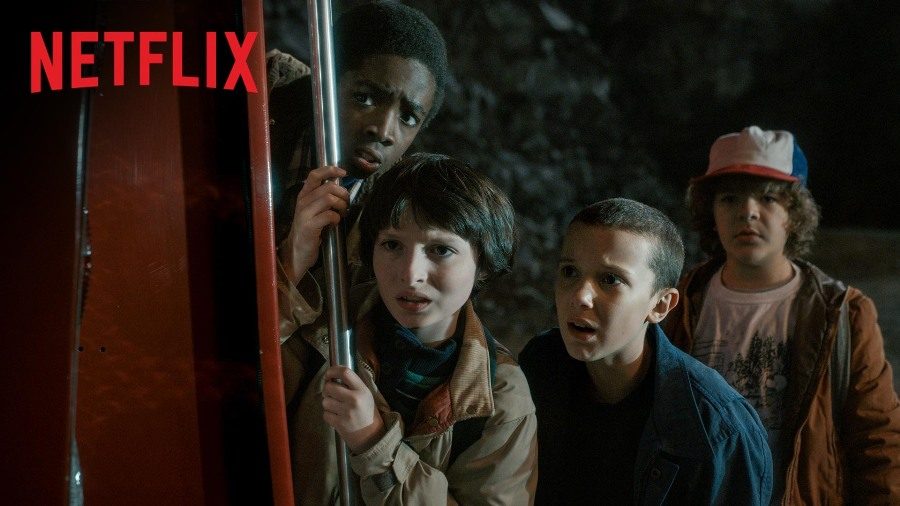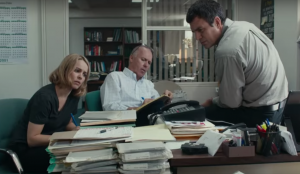‘Stranger Things’ a not-so-strange success
Mike Wheeler (Finn Wolfhard), Lucas Sinclair (Caleb McLaughlin), Dustin Henderson (Gaten Matarazzo), and the strange girl who goes by Eleven (Millie Bobby Brown), look on in shock at a new development in Will Byer’s disappearance. These four endearing and realistic characters kept audiences invested throughout the Netflix original series “Stranger Things”.
September 7, 2016
While Hollywood was busy cranking out summer blockbusters, Netflix was pairing up with the writer-director duo the Duffer Brothers to bring us the sci-fi drama series “Stranger Things” this July. It instantly proved itself as one of the most remarkable TV events of 2016.
The show takes place in 1983 and follows the small town of Hawkins, Indiana, after the vanishing of local middle-schooler Will Byers. Distinct groups of people form around the incident, all separately pursuing the common goal of finding the missing boy and uncovering the conspiracy that led to his disappearance.
Critics have been raving about the series for a myriad of reasons, but what ultimately allowed it to be successful was the real and interesting characters, and their development throughout the brief, but fully fleshed out 8-episode story.
The audience first encounters the three best friends of Will, Mike, Lucas and Dustin, halfway through one of their extensive Dungeons and Dragons campaigns. Their social status is less than desirable, and the three of them are subject to rather cruel teasing from other students. After Will goes missing, they lose all interest in school, AV Club, and other concerns typical of middle schoolers, desperately holding on to the belief that their friend still alive. While searching for Will, they encounter and eventually befriend a strange girl with unknown origins called Eleven (Millie Bobby Brown).
What makes the kids in “Stranger Things” work well as characters is that they mimic real life, allowing the audience to become attached to them. Their constant cursing, talking over one another, and hurling of half-hearted insults are all an accurate representation of how actual kids act. While this is a huge help in the balance of humor and horror in the show, when things get serious, the ability of the young actors still shines through. Mike (Finn Wolfhard) and Lucas (Caleb McLaughlin) get into a few high-intensity confrontations, mostly revolving around whether or not Eleven can be trusted, with Dustin (Gaten Matarazzo) trying to act as a mediator. Despite the demands of these scenes, the cast maintains tension and makes viewers genuinely worry for the characters.
Another particular standout among the characters is the Hawkins Police Chief, Jim Hopper (David Harbour). He finds an alliance with Will’s grief-stricken mother, Joyce (Winona Ryder), and soon takes on personal responsibility for the lost boy. Hopper has a definite comedic side, delivering great lines like “mornings are for coffee and contemplation,” a phrase that has already made its way on quite a few Etsy mugs. Hopper seems at first to be rather dismissive, but proves himself more than admirable by the end of the series. In addition, the writers make a strategic choice by revealing Hopper’s intriguing backstory a little bit at a time.
Something very remarkable about the series, for which it has been acclaimed in nearly every review, is its clever use of 80’s nostalgia. For one, there are many nods to Spielberg’s “E.T. the Extra-Terrestrial”. Mike, Lucas, and Dustin, prefer bikes as a form of transportation, a direct mirror to Elliot and his posse throughout the film. The mysterious girl Eleven’s mannerisms and speech often recall those of the alien E.T. Whether it’s “E.T.”, “The Goonies”, or “Poltergeist”, anyone who’s seen a few 80’s classics will have memories flooding back while watching “Stranger Things”.
Not only does the series incorporate countless examples of iconography from 80’s movies, “Stranger Things” constantly proves that it’s a perfect marriage between the old and the new. Even its title sequence reinforces this idea. Vox investigated the ominous, nearly half-minute long intro, and they found a few very interesting things. The “Stranger Things” animation team used a combination of physical and digital techniques in order to mirror title cards from 80’s films, which used a projector and camera. This culminates in something that’s both polished and flawed, and when played alongside an eerie synth track by “Survive”, it effortlessly encapsulates the theme of the show.
One potential worry for “Stranger Things” could be the prospect of a second season. Show creator Matt Duffer has said that the second installment will be “a little darker, and a little weirder.” This indicates there’s some ideas going on behind the scenes, but the question still remains as to whether the series can uphold its level of quality. The plot, despite being engaging, is relatively straightforward, without any major sub-narratives or twists. The simplistic chain of events worked for the 8-episode span, but it’s hard to imagine how the story could be dragged out. The few loose ends left after the finale, though, inspire a sense of hope that the writers/directors, the Duffer Brothers have something up their sleeve.
Anxieties towards the future aside, what we have of “Stranger Things” is expertly crafted cinema. It has an ability to draw viewers in with the 80’s nostalgia, and keep them interested by filling every episode with suspense and life-like, lovable characters.









Anna Samson • Sep 12, 2016 at 9:29 pm
I really enjoyed this, but I think that it would be cool to mention that this show was filmed in the Fayetteville area.